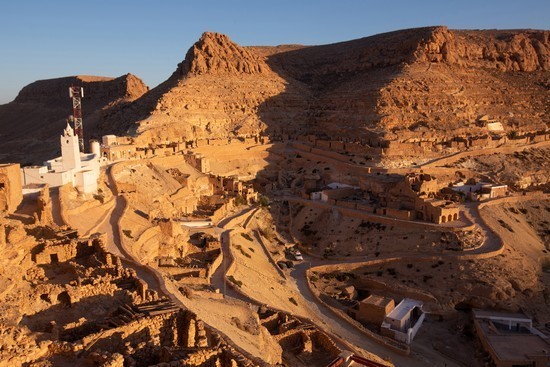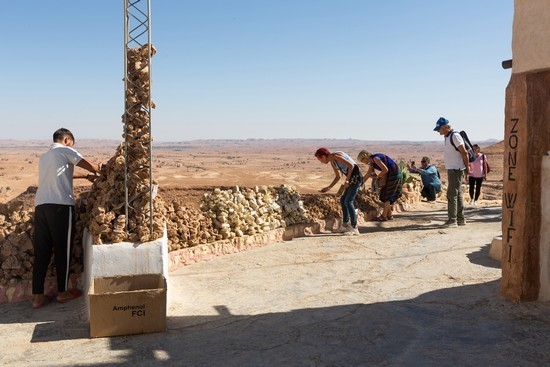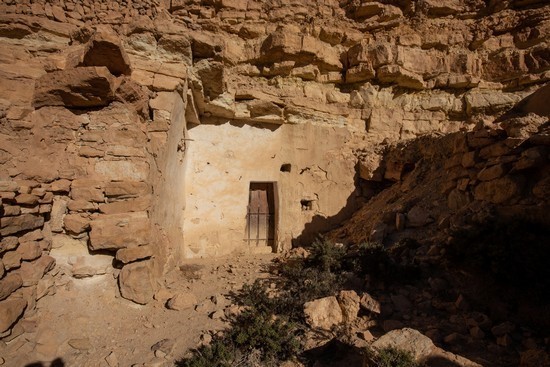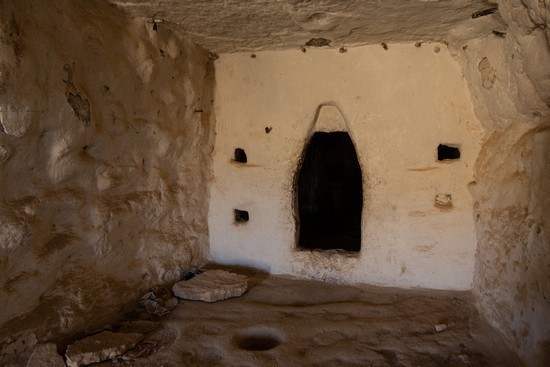CHENINI, Tunisia — As night settled
on the mountain cave where she lives with her mother and her last remaining
younger sibling, Halima Najjar looked out at her dwindling village — a few
dozen specks of light clinging to the dimming mountainside — and wondered if
there would be more to her life one day.
اضافة اعلان
The prospects seemed thin.
On this high, sun-bronzed crag deep in
Tunisia’s southern desert, where roughly 500 Amazigh farmers and herders
inhabit caves hewed out of the rock, people tend to either hope that things
stay as they have been for centuries — or risk everything to get out.
 The cave village of Chenini in Tunisia’s
southern desert.
The cave village of Chenini in Tunisia’s
southern desert.
But the old life of pressing olives and
herding sheep is faltering in the face of an implacable drought. And Najjar,
38, does not want to risk death to migrate by boat to cold, hostile-seeming
Europe, as so many siblings, neighbors, and
fellow Tunisians have.
“I want to leave for my future. I want to try something new, do something with my life. But it’s difficult for us.”
“We still have some blessings here. We’re a
community,” Najjar said. “Still, I want to leave for my future. I want to try
something new, do something with my life. But it’s difficult for us.”
In the evening’s stillness, somebody’s
goats were bleating, someone’s donkey braying. A rooster, befuddled, was
announcing dawn.
“We are together, and then, every time
somebody grows up, they leave,” said her mother, Salima Najjar, 74. She sighed.
“We are left alone here.”
Tunisia’s cave villages, then and nowNearly 1,000 years ago, the people who
first built Chenini and nearby cave villages like it did so to protect their
precious food stores from raiders. Using the golden stone under their feet for
camouflage, they erected a granary that crowned their chosen mountain like a
fortified citadel, then hollowed vaults for living out of the mountainside just
beneath.
They prospered by adapting to the harsh
desert conditions, harvesting olives after they fell from the trees to produce
what they said was longer-lasting oil, and hoarding food against the next
drought. Their olive groves and farm fields mapped the desert below for miles
around.
 Tourists
visit the cave village of Chenini in Tunisia’s southern desert on October 25,
2022.
Tourists
visit the cave village of Chenini in Tunisia’s southern desert on October 25,
2022.
On the mountain, their cave dwellings
sheltered them from summer heat and winter cold. A few of their descendants —
the modern-day Amazigh, as they call themselves, though much of the world knows
them as Berbers — still live in caves that have been modernized to some degree,
sleeping inside and cooking and keeping livestock out front.
Holding on to the old CheniniThe rest are gone and going. From
Chenini’s only cafe, the villagers can see the concrete cluster that is New Chenini, one
of the settlements the government built after Tunisia’s 1956 independence from
France to draw the region’s people down from the mountaintops and into modern
life.
In New Chenini, there was running water and
electricity, conveniences the ancient mountainside village lacked until a
decade or two ago. The 120 or so families who live in New Chenini can come and
go via a paved road, while their relatives back in the original Chenini still
haul everything partway up the mountain by hand or donkey.
With the advent of TV, the internet, and more contact with the rest of the world, some traditions have begun to waver.
But neither village had enough jobs to go
around or much to entertain young people. Over time, many moved to Tunis, the
capital, or to France and other parts of Europe, looking for work. Over time,
as young men migrated, it was mostly women, children, and old men who filled
the villages.
 An
ancient cave home, now uninhabited, in the village of Chenini.
An
ancient cave home, now uninhabited, in the village of Chenini.
Many of the region’s other mountain
villages were abandoned, their granaries turned into tourist attractions or, in
at least one case, a “Star Wars” filming location. But Chenini and a few others
held on, despite an isolation that holds its romance only up to a point.
‘Life is hard, but life is good’Besides the cafe, Chenini’s amenities
consist of a single grocery store, a primary school, a mosque, and a clinic
where a doctor from the closest city can be found once a week. High school
students and medical emergencies must get to
Tataouine, the region’s commercial
hub, about half an hour away. There is no movie theater, no playground, and few
streetlights. Internet did not arrive until about 2013.
Against such disadvantages, the mountain
offers pure air, head-clearing views, and deep sleep. From the whitewashed
mosque atop a high ridge, the muezzin’s call to prayer reverberates solemnly
off the surrounding rocky spurs, a sound that seems to render all others
irrelevant.
“Life is hard, but life is good,” said Ali
Dignichi, 28, a Chenini tour guide. “Many people are rich — they have
everything. But they’re not happy. If we had everything, life would have no
sense. We need to work, bit by bit.”
 Omar
Moussaoui (center), one of Chenini’s two remaining cave-diggers, socializes
with friends in the village in Tunisia’s southern desert on October 26,
2022.
Omar
Moussaoui (center), one of Chenini’s two remaining cave-diggers, socializes
with friends in the village in Tunisia’s southern desert on October 26,
2022.
In late spring of most years, the villagers
harvest wheat, barley, and lentils. At summer’s height they venture into the
desert to collect figs and cactus pears; in October they shake dates from the
palms of a nearby oasis. In December, they begin the all-important olive
harvest.
Starting in February, they haul their
olives to a traditional press. A camel walks in circles for hours, rotating a
giant stone that squeezes out dozens of liters of olive oil — a bounty that can
pay for a child’s
schooling that year.
During wedding season, in summer, the whole
village comes out to celebrate each couple with a week of couscous, lamb,
drumming, and music from the bagpipe-like mizwad, plus, in recent years, a DJ.
If any family does not have enough, the villagers pool their pantry contents to
make sure everyone is fed.
Two remaining cave-diggersBut with the advent of TV, the internet,
and more contact with the rest of the world, some traditions have begun to
waver.
 An
uninhabited cave dwelling in the village of Chenini.
An
uninhabited cave dwelling in the village of Chenini.
These days, almost nobody makes their own
couscous anymore. The only two cave-diggers remaining in town now build new
homes with right angles, floorboards, and tiles, as modern taste demands,
instead of the old lime-painted vaults with their sand floors and curvy walls
that recall the lines of a Georgia O’Keeffe painting. Inside, families sleep
tucked into a series of alcoves lit by a kerosene lamp, keeping their
belongings on shelves carved from the rock.
“One day, maybe, this village will be empty of people… And if we get scattered elsewhere, we won’t have the same traditions.”
“One day, maybe, this village will be empty
of people,” said Omar Moussaoui, 45, one of Chenini’s two remaining
cave-diggers, as he sat at the cafe one evening, looking down at the twinkle of
New Chenini. “And if we get scattered elsewhere, we won’t have the same
traditions. If I go to Tunis, I’ll forget about all these traditions.”
He exhaled, and smoke from his cigarette
drifted across the view.
Read more Lifestyle
Jordan News











